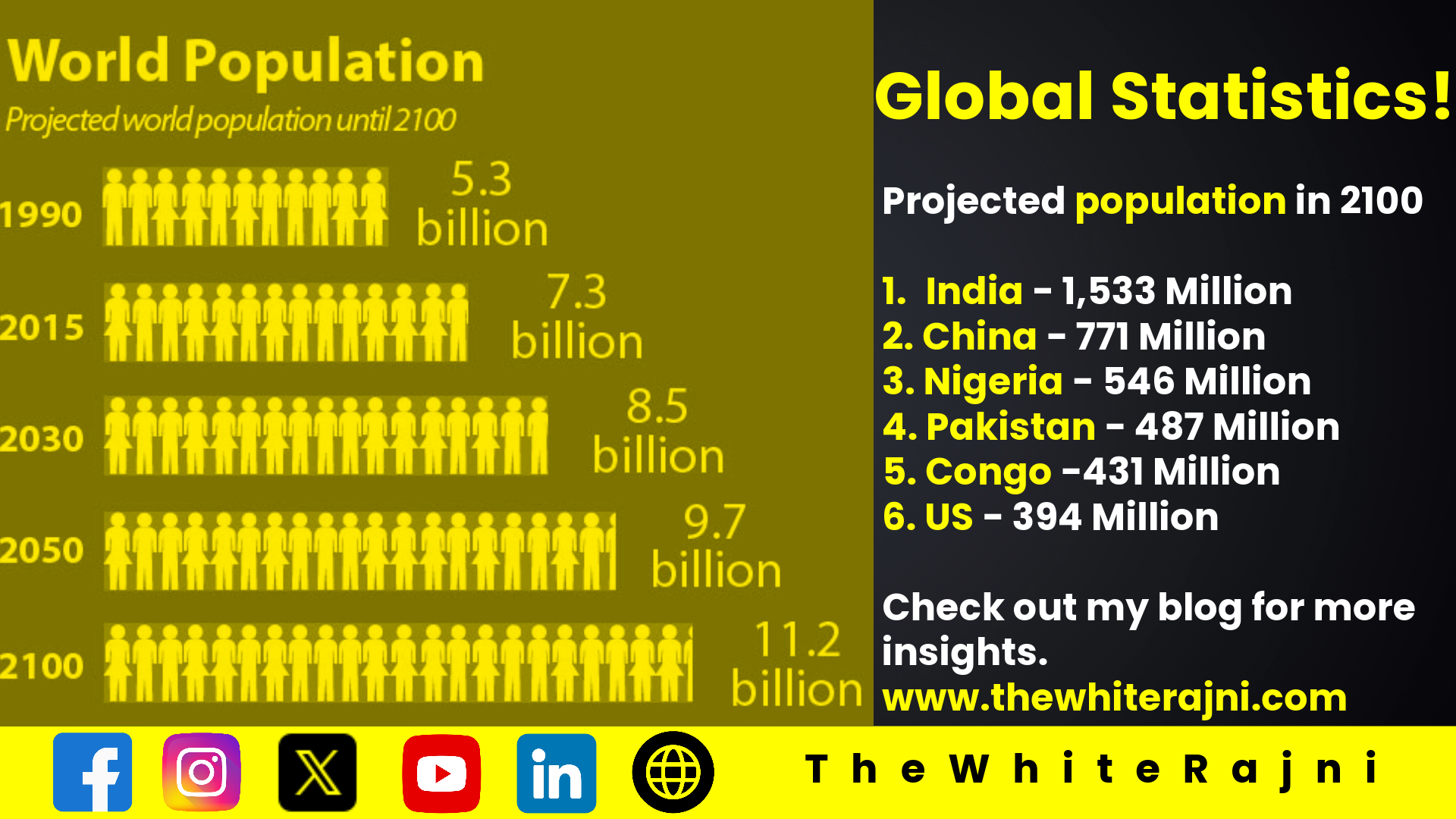Have you ever wondered what the world’s population will look like in the distant future? By 2100, our planet will have undergone significant changes in population distribution. Let’s take a glimpse into the future and explore the projected populations of various countries. These numbers are not only fascinating but also critical for understanding the world’s demographic trends.
| Rank | Flag | Country | Projected Population in 2100 | Contribution Compared to World |
|---|---|---|---|---|
| 1 | 🇮🇳 | India | 1,533 Million | 14.81% |
| 2 | 🇨🇳 | China | 771 Million | 7.45% |
| 3 | 🇳🇬 | Nigeria | 546 Million | 5.27% |
| 4 | 🇵🇰 | Pakistan | 487 Million | 4.71% |
| 5 | 🇨🇩 | Congo | 431 Million | 4.17% |
| 6 | 🇺🇸 | US | 394 Million | 3.81% |
| 7 | 🇪🇹 | Ethiopia | 323 Million | 3.12% |
| 8 | 🇮🇩 | Indonesia | 297 Million | 2.87% |
| 9 | 🇹🇿 | Tanzania | 244 Million | 2.36% |
| 10 | 🇪🇬 | Egypt | 205 Million | 1.98% |
| 11 | 🇧🇷 | Brazil | 185 Million | 1.79% |
| 12 | 🇵🇭 | Philippines | 180 Million | 1.74% |
| 13 | 🇧🇩 | Bangladesh | 177 Million | 1.71% |
| 14 | 🇳🇪 | Niger | 166 Million | 1.61% |
| 15 | 🇸🇩 | Sudan | 142 Million | 1.37% |
| 16 | 🇦🇴 | Angola | 133 Million | 1.29% |
| 17 | 🇺🇬 | Uganda | 132 Million | 1.28% |
| 18 | 🇲🇽 | Mexico | 116 Million | 1.12% |
| 19 | 🇰🇪 | Kenya | 113 Million | 1.09% |
| 20 | 🇷🇺 | Russia | 112 Million | 1.08% |
| 21 | 🇮🇶 | Iraq | 111 Million | 1.07% |
| 22 | 🇦🇫 | Afghanistan | 110 Million | 1.06% |
| 23 | 🇲🇿 | Mozambique | 106 Million | 1.03% |
| 24 | 🇻🇳 | Vietnam | 91 Million | 0.88% |
| 25 | 🇨🇮 | Côte d’Ivoire | 88 Million | 0.85% |
| 26 | 🇨🇲 | Cameroon | 87 Million | 0.84% |
| 27 | 🇲🇱 | Mali | 87 Million | 0.84% |
| 28 | 🇲🇬 | Madagascar | 83 Million | 0.80% |
| 29 | 🇹🇷 | Turkey | 82 Million | 0.79% |
| 30 | 🇮🇷 | Iran | 79 Million | 0.76% |
| 31 | 🇿🇦 | South Africa | 74 Million | 0.71% |
| 32 | 🇾🇪 | Yemen | 74 Million | 0.71% |
| 33 | 🇯🇵 | Japan | 74 Million | 0.71% |
| 34 | 🇬🇧 | UK | 70 Million | 0.68% |
| 35 | 🇩🇪 | Germany | 68 Million | 0.66% |
| 36 | 🇫🇷 | France | 60 Million | 0.58% |
| 37 | 🇨🇦 | Canada | 53 Million | 0.51% |
| 38 | 🇸🇦 | Saudi Arabia | 50 Million | 0.48% |
| 39 | 🇦🇷 | Argentina | 47 Million | 0.45% |
| 40 | 🇦🇺 | Australia | 38 Million | 0.37% |
| 41 | 🇮🇹 | Italy | 36 Million | 0.35% |
| 42 | 🇪🇸 | Spain | 30 Million | 0.29% |
| 43 | 🇰🇷 | South Korea | 24 Million | 0.23% |
| 44 | 🇳🇱 | Netherlands | 16 Million | 0.15% |
| 45 | 🇦🇪 | UAE | 14 Million | 0.13% |
| 46 | 🇸🇪 | Sweden | 13 Million | 0.13% |
| 47 | 🇨🇭 | Switzerland | 10 Million | 0.10% |
| 48 | 🇦🇹 | Austria | 8 Million | 0.08% |
| 49 | 🇳🇴 | Norway | 7 Million | 0.07% |
| 50 | 🇩🇰 | Denmark | 7 Million | 0.07% |
| 51 | 🇫🇮 | Finland | 5 Million | 0.05% |
| 52 | 🇸🇮 | Slovenia | 1.6 Million | 0.02% |
| 53 | 🇱🇻 | Latvia | 0.95 Million | 0.01% |
| 54 | 🇪🇪 | Estonia | 0.83 Million | 0.01% |
| 55 | 🇮🇸 | Iceland | 0.37 Million | 0.004% |
🌍 | World | 10.35 Billion | 100.00%
As we explore these projected figures, it’s evident that some countries will experience substantial population growth, while others may see more modest increases or even declines. These demographic shifts will undoubtedly impact global politics, economies, and social structures in the decades to come. It’s essential to keep an eye on these trends as we plan for the future of our planet.










